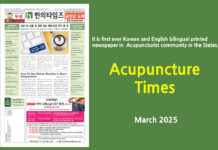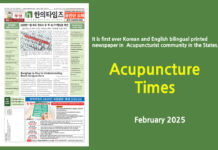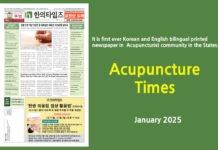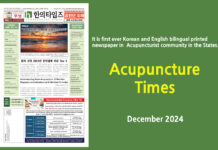A Brief Comparison of Historical Backgrounds and Policies
By Namwook Cho, L.Ac.
In US, Traditional Chinese Medicine (TCM) is representing acupuncture and herbal medicine. That is true but not 100%. East Asian medicine is known to have originated in China about 3,000 years. It was introduced to Korea with Buddhism and to Japan with Chinese culture beginning in the 6th century. It has been widely used following a long history and practices in the three countries strongly influenced each other. Before Western culture was introduced to East Asia in 19th century, traditional medicine was the mainstream medical system to treat all types of disease.
Each country has developed its unique systems: Traditional Chinese Medicine(TCM), Traditional Korean Medicine(TKM), and Oriental Medicine for Japan. Differences among TCM, TKM, and Oriental Medicine were resulted from each countries’ histories, cultural differences, different acceptance of Western culture, and influences of the WW II.
TCM accounts for around 40% of all health care delivered, and it is used to treat about 200 million patients annually in China. In Korea, 69% of population has experienced TKM and 60~70% of allopathic doctors in Japan prescribe herbal medicine. Traditional Medicine of all three countries was included in the national health care systems and developed in national policies based on historical and cultural background.
Development of Traditional Medicine Systems
TCM was banned in 1929 and in 1954, TCM was accepted again and started TCM education in schools. In 1982, Chinese government established a constitution for the development of TCM and in 1999, Chinese National Health Insurance stared cover TCM.
In Korea, TKM was suppressed by Colonial Japanese Government in 1910 and 41 years later, Korean government admitted TKM. Formal TKM education was started as a 6-year course and in 1987, TKM covered by national health insurance.
In Japan, there was the abolition of the traditional medicine system in 1881 and in 1976, traditional medicine was partially covered and in 2001, traditional medicine was included in medical education.
National Policies
All major therapeutic methods of traditional medicine were included in the national health care system in China, Korea, and whereas Japan included only most Kampo which galenicals or herbal mixture and some of acupuncture.
Traditional medicine doctors, whose activities are defined by law and regulated by the government of each country, have three different specialties in China: TCM, integrative medicine, and other ethnic medicine doctors. In Korea, there is only one kind of traditional medicine doctors. The percentage of traditional medicine doctors in medical facilities was the highest in Korea, at 15.26%, followed by China, at 12.63%. For Japan, the percentage of Kampo doctors who are medical doctors and members of nongovernmental academic society, the Japan Society for Oriental Medicine, was estimated to be 0.65% in 2008.
The ratio of medical facilities practicing conventional medicine to facilities practicing traditional medicine was about 25:1 for China for Korea 2.50:1. For Japan, hospitals and clinics are regarded as conventional facilities eve if traditional medicine is practiced, so the ratio for traditional Japanese medicine was recorded as zero.
Medical Insurance Coverage
All three countries have a policy to cover insured traditional medical procedures: China since 1951; Korea since 1987; and Japan only for Kampo since 1976. China and Korea had the most reimbursable treatments: acupuncture, moxibustion, cupping and manual therapies are completely covered, and herbal medicines are partially covered. Coverage of manual therapies was different in each country. Data on the proportion of reimbursement for traditional medicine treatments were not available for China and Japan whereas Korea showed a reimbursement rate of 4.04%.
The article used a research article “Traditional Medicine in China, Korea, and Japan: A Brief Introduction and Comparison” which was published Evidence-Based Complementary and Alternative Medicine Volume 2012, Article ID 429103.





































